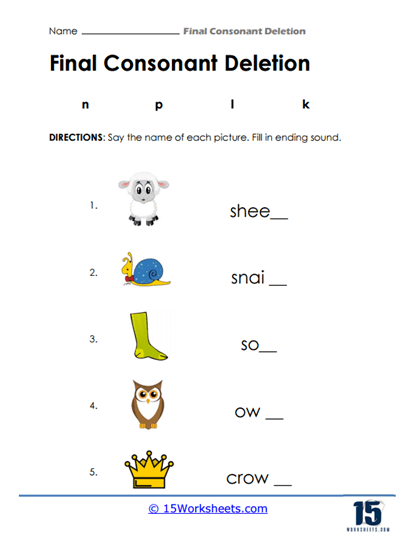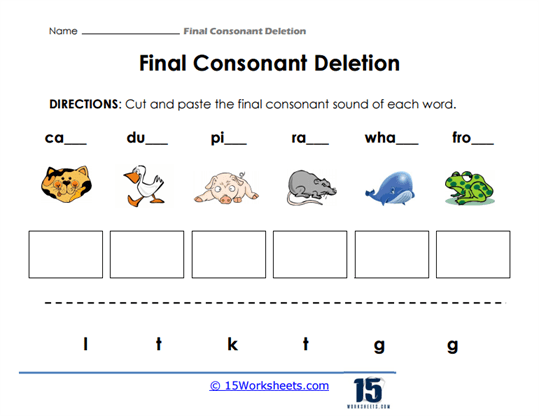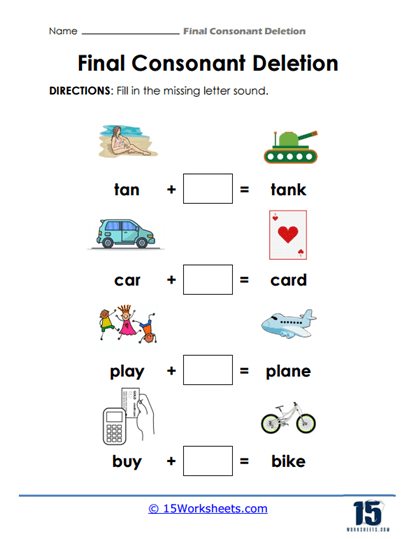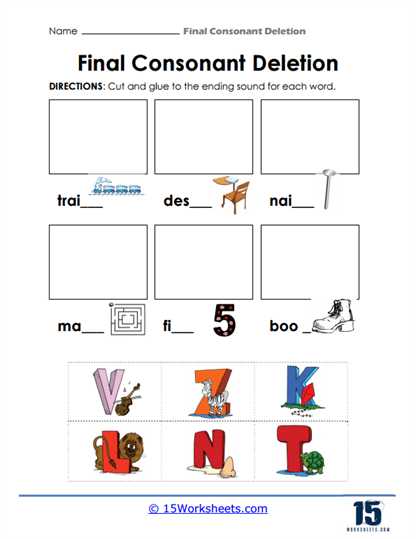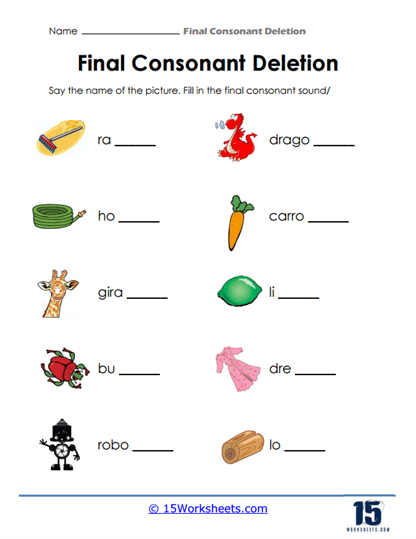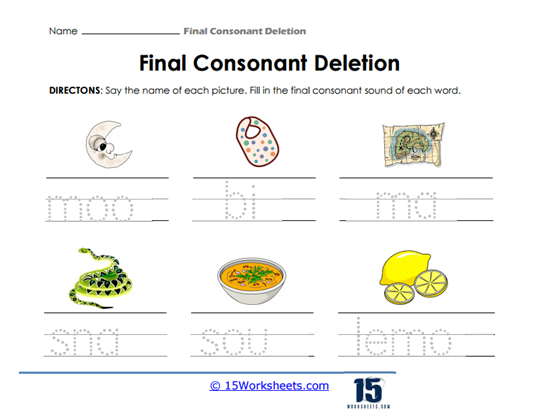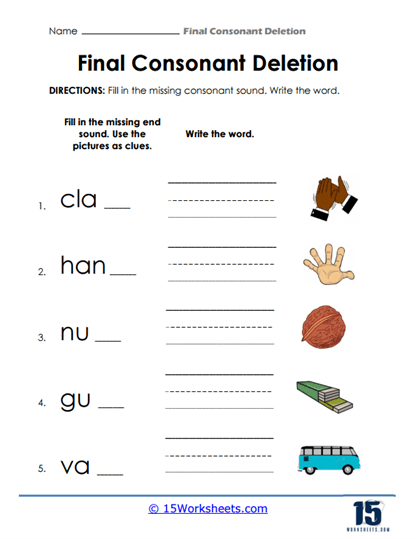Final Consonant Deletion Worksheets
About These 15 Worksheets
Final consonant deletion is an essential aspect of early literacy education, helping young learners develop phonological awareness by focusing on the correct articulation of word endings. This collection of Final Consonant Deletion Worksheets offers a diverse range of engaging activities that are designed to reinforce this critical skill in a fun and interactive way. These worksheets are ideal for teachers, speech therapists, and parents who are looking for effective tools to help children overcome the common challenge of dropping final consonant sounds in their speech.
The worksheets in this series include various types of activities that cater to different learning styles, ensuring that all students can benefit from the exercises. For example, one worksheet presents a matching activity where students are asked to add a final consonant to complete a word, like adding an “m” to “blue” to form the word “bloom.” This type of exercise encourages students to recognize patterns in word formation and strengthens their understanding of how final consonants change word meanings.
A Look At The Worksheets
1. Connecting Sounds and Detecting Patterns
In “Word Linker,” “Sound Detective,” and “Consonant Clues,” students channel their inner linguistic sleuth. They’re on the case, identifying when a final consonant mysteriously disappears-like a cookie vanishing from the jar. “Word Linker” tasks them with attaching word fragments to their proper homes, while “Sound Detective” adds the magnifying glass and trench coat flair, urging kids to notice missing endings despite red herrings. “Consonant Clues” then acts as the grand finale of the investigation: students collect punctuation-style clues to restore those missing letters. It’s like CSI: Final Phoneme Edition-minus the blood splatter.
2. Matching and Mirroring Sounds
“Match Sounds,” “Sound Matchup,” and “Sound Match” form a trio of matching mayhem. These worksheets pit pairs of words-one with its final consonant intact, one with it ghosting away-and challenge kids to connect the dots. It’s a bingo of beginning sounds, with a twist: the endings don’t match, because someone took them. Humor abounds when a child links “cap” to “ca”-because disco parties are apparently stealthy about consonants.
3. Detecting and Finishing Endings
“End Sound,” “Sound Endings” (twice, because apparently it’s a hit), and “Ending Echo” focus less on matching and more on identifying and articulating that elusive final consonant. In “End Sound,” students circle or write the terminal sound, summoning their best detective ears once again. “Sound Endings” (both versions) asks them to reinforce those endings by writing or coloring, like adding the cherry on the ice cream sundae of speech. “Ending Echo,” meanwhile, is a get‑the‑last‑word echo exercise-literally: the worksheet whispers a stem, and the student must shout (or write) the correct consonant-rich finale.
4. Clip, Linking, Plus-Manipulating Sounds
“Consonant Clip,” “Sound Plus,” and “Sound Finish” hand students the power of sound surgery. “Consonant Clip” invites them to clip off the end and then weld it back, physically manipulating word parts like mini phoneme mechanics. “Sound Plus” flips the exercise: students add the missing final sound-it’s like word Tetris, making pieces fit. Finally, “Sound Finish” gives the culminating challenge: they apply all they’ve learned to fully finish each word, giving closure to every linguistic journey. If words were races, this would be the tape-line finish.
5. Final Finds and Letter Match-for the Truly Meticulous
“Final Finds” and “Letter Match” sweet‑talk students into nitpicking letters themselves. “Final Finds” requires them to comb through words and pick out those sly missing end consonants-like hidden objects in visual puzzles, but auditory. “Letter Match” takes it letter by letter: students link final sounds to their written symbols. It’s the moment when phonemic awareness meets letter knowledge-emphasizing that “t” really is a “t” and not just a ghost whispering away at the word’s end.
What Is Final Consonant Deletion?
Final consonant deletion is a phonological process in which a speaker omits the final consonant sound of a word, leaving only the vowel or the preceding consonant-vowel combination. This process is common in the early stages of language development, particularly among young children who are still learning the intricacies of speech and pronunciation. For example, a child might say “ca” instead of “cat” or “doe” instead of “dog.” While this is a natural part of language acquisition, it is important to address and correct final consonant deletion as children progress in their phonics education. Correcting this pattern helps to improve phonics skills by reinforcing the importance of every sound in a word, especially the final consonant, which can significantly change the meaning of the word.
By learning to articulate final consonants clearly, children develop better reading, spelling, and speaking skills, which are essential for effective communication and literacy development. Addressing final consonant deletion ensures that children become more accurate and confident in their use of language, laying a strong foundation for their future academic success.


